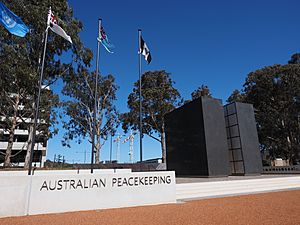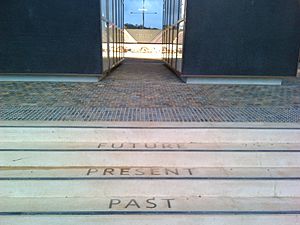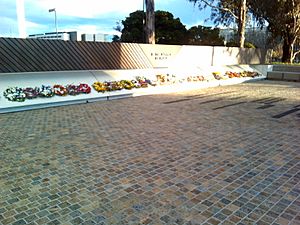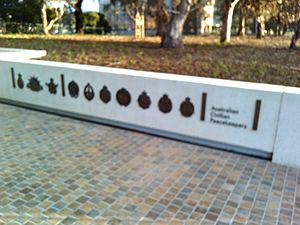Australian Peacekeeping Memorial facts for kids
The Australian Peacekeeping Memorial is a special place in Canberra, Australia. It is located on Anzac Parade. This memorial remembers all Australians who have worked for peace around the world. These brave people are called peacekeepers or peacemakers.
The memorial was officially opened on 14 September 2017. General Sir Peter Cosgrove, who was the Governor-General of Australia at the time, opened it. It honors all Australian peacekeepers, from the past, present, and future.
Contents
What Does the Memorial Look Like?
The memorial has three main parts. These parts show the different roles of Australian peacekeepers. They include military members, police officers, and civilians. All of them work for international peace and safety.
The Monoliths and Golden Light
The first part is two tall, black, shiny stone walls called Monoliths. They stand for the "opposing forces of conflict." This means they represent the disagreements that lead to fighting. Between these walls is a path of golden light. This light comes from glowing onyx stone. It shows the "light of hope for the future" that peacekeepers bring. They help create peace and safety in troubled places.
The Courtyard of Reflection
After passing through the golden light, you enter a cobblestone Courtyard. This is a calm space for people to think and remember. It is also used for special ceremonies. On the ground, there are bronze plaques. These plaques have words describing the qualities of Australian Peacekeepers. They talk about their values, actions, and goals for international peacekeeping.
The Commemorative Beam
At the back of the courtyard is the third part. It is a large, black, shiny stone beam. This beam shows the strength and stability that comes from peacekeeping. Bronze plates on the beam list the many missions where Australians have served. These include missions for the United Nations and other groups. Below the beam, there is a white area. This is where people can place wreaths or flowers to remember those who served.
At the front of the memorial, you can see crests. These are symbols of the organizations that Australian Peacekeepers have worked with. On the side, there are symbols of the groups they came from.
Why Was the Memorial Built?
Australians have been involved in peacekeeping missions since 1947. On 14 September 1947, four Australian military observers went to Indonesia. They helped watch over a ceasefire. Since then, over 60,000 Australians have served as peacekeepers. Some have died or been injured during their service. Their experiences have also affected their families.
Many Australians returned from missions in East Timor. This led people to suggest building a national memorial. The idea was supported by leaders in the Australian Defence Force and the Australian Federal Police. Other groups for veterans also joined in. They wanted a special place to remember peacekeepers. Before this, there were only a few small plaques around the country.
How the Memorial Project Started
In 2005, a committee was formed. It included people from different veterans' groups. It also had members from the Australian Defence Force and the Australian Federal Police. This committee created the Australian Peacekeeping Memorial Project (APMP). Their goal was simple: to build a national peacekeeping memorial on Anzac Parade in Canberra.
Major General Tim Ford (retired) led this committee. He had a long career in the Australian Army. He also worked for the United Nations in peacekeeping roles. Other skilled people helped the committee. For example, Mr. Warren Lewis, an engineer, helped manage the building plans.
Designing the Memorial
In 2008, a competition was held to find a design. Architects in Australia could submit their ideas. The design needed to show Australia's peacekeeping work. It also had to look good and cost less than $3 million. Many designs were submitted, and four were chosen for more development.
On 19 December 2008, the winning design was announced. It was from an architectural company called Super Colossal (now Bennett and Trimble). The committee liked its simple look and how it showed the work of peacekeepers. They also liked that it fit the Australian landscape and was not too expensive.
Building the Memorial
The design plans were finalized in 2009. Then, in 2010, a company called Manteena Pty Ltd was chosen to build the memorial. Manteena had experience building other national memorials in Canberra.
Testing the Design
When Manteena was chosen, there were not enough funds to start full construction. However, there was enough money to build a test version. This "prototype program" helped check the materials and building methods. It also helped solve any problems before the main construction began. This testing saved time and money later on.
Special Materials
After the testing, special materials were ordered. These included golden onyx stone panels from Mexico. They were cut and polished in Italy. Toughened glass was added to protect them from weather and damage. These panels create the golden passageway between the monoliths. The cobblestone pavers for the courtyard came from a quarry in South Australia. All these materials arrived in Canberra by August 2014.
Construction Stages
In September 2015, the Australian government provided a large grant. This allowed the first stage of construction to begin. This stage included the courtyard, lighting, and the Commemorative Beam. The two monoliths and bronze plaques were planned for a later stage.
In February 2017, the government gave another grant. This meant the entire memorial could be completed. Despite some changes to the building plan, the memorial was mostly finished. It was ready for its dedication on 14 September 2017. This date marked 70 years since Australia's first peacekeepers deployed.
How the Project Was Paid For
At first, many Australian businesses and the government gave money. However, fundraising became slow, partly due to the 2008 financial crisis. Many people and companies focused on other important causes.
The Australian government eventually provided 75% of the project's cost. Australian businesses and veteran groups gave 20%. Individuals donated the remaining 5%. The total cost of the memorial was $4.1 million.
Dedication Ceremony
The Australian Peacekeeping Memorial was officially dedicated on 14 September 2017. The Governor-General, General Sir Peter Cosgrove, led the ceremony. His wife, Lady Lyn Cosgrove, represented the families and friends of peacekeepers.
Other important guests included the Minister for Veterans’ Affairs. General David Hurley, who was the Governor of New South Wales, was also there.
September 14 is Peacekeeping Day in Australia. It marks the day Australia's first peacekeepers went to Indonesia in 1947. The ceremony celebrated both the new memorial and 70 years of Australian peacekeeping. Many veterans, their families, and current peacekeepers attended. Ambassadors and members of the public were also present. The local Ngunnawal aboriginal tribe was honored. They performed a "welcome to country" ceremony.
Ceremonies at the Memorial
Before the memorial was built, temporary ceremonies were held on the site. These events marked Peacekeeping Day each year. They honored the service and sacrifice of Australian peacekeepers.
Now that the memorial is built, different groups can organize ceremonies there. The National Capital Authority must approve any ceremony held at the memorial. This is true for all memorials on Anzac Parade.
Keeping the Memorial Maintained
The National Capital Authority (NCA) is in charge of looking after the memorial. They make sure it stays in good condition. The NCA also adds new mission plaques to the memorial's beam. When Australians go on a new peacekeeping mission, a new plaque is added. If a mission ends, its plaque is updated to show the completion year.
Peacekeeping Missions Honored
The memorial lists all the peacekeeping missions where Australians have served. When the memorial was dedicated, there had been 62 such missions.





